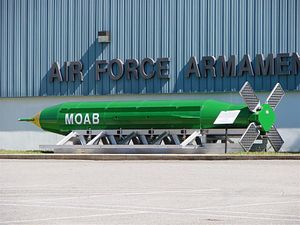The United States Air Force Special Operations Command conducted a targeted strike on an ISIS tunnel complex in Achin district, Nangarhar province in Eastern Afghanistan on April 13 using one of its largest non-nuclear bombs in its arsenal, the GBU-43/B Massive Ordnance Air Blast, commonly known as the Mother of All Bombs (MOAB).
It was the first time that the U.S. military used the GBU-43 MOAB in combat.
“The strike was designed to minimize the risk to Afghan and U.S. Forces conducting clearing operations in the area while maximizing the destruction of ISIS-K fighters and facilities,” an April 13 U.S. Central Command press release stated.
The bomb was dropped from a Lockheed MC-130.
“U.S. Forces took every precaution to avoid civilian casualties with this strike,” the statement continues. “U.S. Forces will continue offensive operations until ISIS-K is destroyed in Afghanistan.”
The statement did not say how many militants were killed in the strike. According to Voice of America Afghanistan, the governor of Nangarhar had no prior information about the United States’ intention to use the bomb in his province.
Former Afghan President Hamid Karzai condemned the use of the GBU-43 MOAB on Afghan territory. “This is not the war on terror but the inhuman and most brutal misuse of our country as testing ground for new and dangerous weapons. It is upon us, Afghans, to stop the USA,” Karzai said on Twitter.
The United States alone has dropped an estimated 12,000 bombs in Afghanistan since 2012 killing over a thousand civilians.
The GPS-guided GBU-43 bomb, which is 30 feet long and weighs 21,600 pounds, is not a penetrator weapon and intended for use against softer targets spread out over an extended area given the size of the explosion. Due its relatively thin casing, the bomb is designed for a surface burst.
“It is expected that the weapon will have a substantial psychological effect on those who witness its use,” a Global Security analysis states. “The massive weapon provides a capability to perform psychological operations, attack large area targets, or hold at-risk threats hidden within tunnels or caves.” The analysis also claims that the weapon is “the largest-ever satellite-guided, air-delivered weapon in history.”
The weapons filling weight is 18,700 pounds of H6 (an explosive composition) and has a blast yield of around 11 tons of TNT. Some U.S. media reports falsely reported that the GBU-43 releases almost as much energy a as the nuclear bomb dropped on Hiroshima in 1945. However, as the nuclear policy scholar James Acton pointed out, the Hiroshima bomb yielded about 15 kilotons of TNT, whereas the GBU-43 release “is about 0.08 percent (~0.1 percent) of that.”
While it is highly unusual for the U.S. military to publish a press release about the dropping of a single bomb in Afghanistan, the statement is likely part of a larger psychological warfare operation to reduce the fighting morale of ISIS fighters in Eastern Afghanistan at the outset of the 2017 fighting season.

































